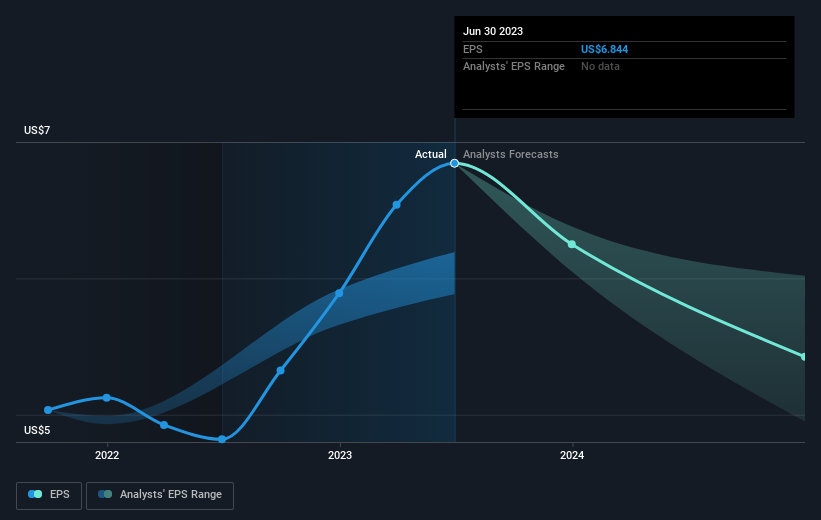The worst result, after buying shares in a company (assuming no leverage), would be if you lose all the money you put in. But when you pick a company that is really flourishing, you can make more than 100%. For example, the BancFirst Corporation (NASDAQ:BANF) share price has soared 117% in the last three years. That sort of return is as solid as granite. On the other hand, we note it’s down 8.1% in about a month.
So let’s investigate and see if the longer term performance of the company has been in line with the underlying business’ progress.
View our latest analysis for BancFirst
There is no denying that markets are sometimes efficient, but prices do not always reflect underlying business performance. By comparing earnings per share (EPS) and share price changes over time, we can get a feel for how investor attitudes to a company have morphed over time.
During three years of share price growth, BancFirst achieved compound earnings per share growth of 26% per year. We note that the 29% yearly (average) share price gain isn’t too far from the EPS growth rate. Coincidence? Probably not. That suggests that the market sentiment around the company hasn’t changed much over that time. On the contrarythe share price change has arguably mimicked the EPS growth.
The image below shows how EPS has tracked over time (if you click on the image you can see greater detail).

We consider it positive that insiders have made significant purchases in the last year. Having said that, most people consider earnings and revenue growth trends to be a more meaningful guide to the business. Dive deeper into the earnings by checking this interactive graph of BancFirst’s earnings, revenue and cash flow.
What About Dividends?
As well as measuring the share price return, investors should also consider the total shareholder return (TSR). The TSR incorporates the value of any spin-offs or discounted capital raisings, along with any dividends, based on the assumption that the dividends are reinvested. Arguably, the TSR gives a more comprehensive picture of the return generated by a stock. As it happens, BancFirst’s TSR for the last 3 years was 131%, which exceeds the share price return mentioned earlier. The dividends paid by the company have thusly boosted the total shareholder return.
A Different Perspective
While the broader market gained around 15% in the last year, BancFirst shareholders lost 8.1% (even including dividends). Even the share prices of good stocks drop sometimes, but we want to see improvements in the fundamental metrics of a business, before getting too interested. On the bright side, long term shareholders have made money, with a gain of 10% per year over half a decade. If the fundamental data continues to indicate long term sustainable growth, the current sell-off could be an opportunity worth considering. It’s always interesting to track share price performance over the longer term. But to understand BancFirst better, we need to consider many other factors. For instance, we’ve identified 1 warning sign for BancFirst that you should be aware of.
BancFirst is not the only stock that insiders are buying. For those who like to find winning investments this free list of growing companies with recent insider purchasing, could be just the ticket.
Please note, the market returns quoted in this article reflect the market weighted average returns of stocks that currently trade on American exchanges.
What are the risks and opportunities for BancFirst?
BancFirst Corporation operates as the bank holding company for BancFirst that provides a range of commercial banking services to retail customers, and small to medium-sized businesses.
Rewards
-
Trading at 38.8% below our estimate of its fair value
-
Earnings grew by 42.8% over the past year
Risks
-
Earnings are forecast to decline by an average of 13.7% per year for the next 3 years
Have feedback on this article? Concerned about the content? Get in touch with us directly. Alternatively, email editorial-team (at) simplywallst.com.
This article by Simply Wall St is general in nature. We provide commentary based on historical data and analyst forecasts only using an unbiased methodology and our articles are not intended to be financial advice. It does not constitute a recommendation to buy or sell any stock, and does not take account of your objectives, or your financial situation. We aim to bring you long-term focused analysis driven by fundamental data. Note that our analysis may not factor in the latest price-sensitive company announcements or qualitative material. Simply Wall St has no position in any stocks mentioned.





